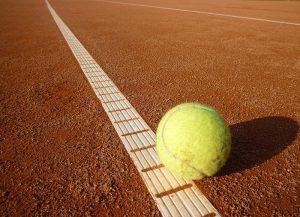We may earn money or products from the companies mentioned in this post.
Introduction

Welcome to the thrilling world of tennis, where every match is a battle of skill, endurance, and strategy In this blog post, we will delve into the exciting Round of 16 in tennis tournaments This pivotal stage marks a turning point in the competition, where some players emerge victorious while others bid farewell to their title dreams
Definition of Round of 16 in Tennis
The Round of 16 refers to the stage in a tennis tournament where only 16 players remain standing It occurs after the initial rounds, typically the first week or so, where numerous contestants compete against each other to secure a spot in this crucial phase
During this round, eight matches are played as the remaining participants clash on the court for a chance to advance further in the tournament The winners of these matches move on to join the elite group known as the quarterfinalists
Importance and Relevance within a Tournament Structure
The Round of 16 holds immense significance within a tennis tournament structure It represents a significant milestone for both players and fans alike As one might expect, reaching this stage is no easy feat; it requires exceptional skill and determination
For participants who have made it through grueling battles in earlier rounds, reaching the Round of 16 signifies that they have overcome substantial obstacles and proven themselves capable contenders At this point, they are just a few victories away from potentially lifting the coveted trophy
Furthermore, from a spectator’s perspective, this round often showcases exhilarating matchups between top-ranked players or rising stars who have managed to upset higher-seeded opponents along their journey These encounters can offer intense moments filled with suspense and highlight-reel shots that leave audiences captivated
Overview of the Blog Post
In this blog post, we will explore the Round of 16 in tennis tournaments from various angles We will discuss the strategies employed by players during this crucial stage, analyze memorable matches that have taken place at this juncture, and examine the impact it has on players’ rankings and overall tournament dynamics
Additionally, we will delve into the psychological aspect of competing in such high-stakes scenarios and how players manage to maintain their focus amidst mounting pressure We will also touch upon the history of notable Round of 16 matchups and how they have shaped tennis history
So, join us as we unravel the excitement and drama surrounding the Round of 16 in tennis tournaments Whether you are an avid fan or a casual observer, there is something for everyone to appreciate in this pivotal phase of competition
Tournament formats and progression to the Round of 16

Tennis tournaments come in various forms, from the prestigious Grand Slams to the ATP Tour and WTA Tour events Each tournament has its own unique structure and rules, which greatly impact how players progress to the Round of 16
Types of tennis tournaments: Grand Slams, ATP Tour, WTA Tour, etc
When it comes to tennis tournaments, there is a wide range of options available The Grand Slam tournaments – Australian Open, French Open, Wimbledon, and US Open – are undoubtedly the most prestigious events in the sport They attract top-ranked players from all over the world and offer significant prize money
The ATP (Association of Tennis Professionals) Tour and WTA (Women’s Tennis Association) Tour consist of a series of tournaments throughout the year that allow players to accumulate ranking points These events vary in terms of prize money, prestige, and surface type From hard courts to clay courts and grass courts, each tournament presents a unique challenge for participants
Comparison between different tournament structures
While all tennis tournaments have their own specificities regarding format and organization, they generally follow a similar pattern Players compete in multiple rounds until reaching the ultimate goal – winning the championship title
In some tournaments, such as Grand Slams or major ATP/WTA events, there are usually 128 participants in singles competitions This means that players need to navigate through seven rounds before reaching the Round of 16
How each tournament format impacts the Round of 16
The tournament format directly influences how players advance to the Round of 16 In larger events like Grand Slams or major ATP/WTA tournaments with a draw size of 128 players, the initial rounds consist of matches between lower-ranked players and qualifiers The winners progress to face higher-ranked opponents in subsequent rounds
On the other hand, smaller tournaments with a draw size of 32 or 64 players may have fewer qualifying rounds before reaching the Round of 16 This means that higher-ranked players may enter the competition at a later stage, sometimes directly into the Round of 32 or even the Round of 16
Seeding system in tennis tournaments

In order to ensure fairness and competitiveness, tennis tournaments implement a seeding system Seeding refers to the practice of assigning rankings to top players before a tournament starts These rankings determine their placement in the draw and help avoid early-round clashes between high-ranked competitors
Explanation of seeding and its purpose in a draw
The purpose of seeding is to give an advantage to higher-ranked players by placing them on opposite sides of the draw This prevents them from meeting each other until later stages in the tournament, usually after reaching the Round of 16 By doing so, organizers aim to create more exciting matchups and increase suspense as the event progresses
How seeding affects the Round of 16 matchups
The seeding system has a direct impact on how Round of 16 matchups are determined Typically, higher-seeded players will face lower-seeded opponents who have advanced through earlier rounds This ensures that top-ranked players have a fair chance to progress deeper into the tournament without facing their toughest challengers too early
Progression from earlier rounds to the Round of 16

The journey from earlier rounds to reach the Round of 16 can be arduous for tennis players Before even entering this stage, participants must go through several qualification rounds and early-round matches
Qualification rounds and early round matches leading up to the Round of 16
In many tournaments, particularly those with larger draw sizes, there are preliminary rounds where lower-ranked players or qualifiers compete for a spot in the main draw These qualification rounds can be highly competitive, as talented players fight for a chance to face higher-ranked opponents in the main event
Once the main draw begins, players face off against each other in early-round matches These matches often feature exciting battles between competitors of varying skill levels, providing fans with thrilling tennis moments
Walkovers, retirements, and withdrawals affecting entry into this round
Occasionally, unforeseen circumstances such as injuries or personal reasons can lead to walkovers (when one player doesn’t show up), retirements mid-match, or withdrawals from the tournament altogether These occurrences can impact how players progress to the Round of 16 – sometimes resulting in unexpected opportunities for lower-ranked participants who may have faced tougher opponents otherwise
Notable players, rivalries, and moments in the history of Round-of-16 matches

Memorable matches involving top players
When it comes to Round-of-16 matches, some encounters stand out as truly memorable In high-profile competitions like Grand Slam events, the level of competition reaches its peak and top players battle fiercely for a spot in the quarterfinals
One unforgettable match took place at Wimbledon in 2008 between Rafael Nadal and Roger Federer The two tennis titans showcased their exceptional skills over five grueling sets, with Nadal emerging victorious in what is widely regarded as one of the greatest tennis matches of all time
In another remarkable encounter, Serena Williams faced Maria Sharapova at the Australian Open in 2005 Both players displayed incredible athleticism and determination, but it was Serena who triumphed after an intense three-set battle
Rivalries that have played out during this stage
The Round-of-16 stage has witnessed some captivating rivalries throughout tennis history These head-to-head matchups have added an extra layer of excitement to the tournament and kept spectators on the edge of their seats
A classic rivalry that frequently unfolded at this stage was between Andre Agassi and Pete Sampras Their contrasting styles of play and fierce competitive spirit made for electrifying encounters whenever they met in the Round-of-16 Each match brought anticipation and unpredictability to fans worldwide
Another enduring rivalry that captured attention was between Novak Djokovic and Stan Wawrinka Their battles at this stage were marked by intense rallies, powerful shots, and breathtaking shot-making abilities These clashes not only impacted player performance but also generated immense spectator interest due to their undeniable chemistry on court
Milestones achieved by players in their journey through the Round-of-16 stage
As players navigate their way through the Round-of-16, they often achieve significant milestones that shape their careers and leave a lasting impact on tennis history
One such milestone was accomplished by Serena Williams at the US Open in 2015 After facing a challenging Round-of-16 match against Madison Keys, Serena went on to secure her 308th Grand Slam match win, surpassing Martina Navratilova’s long-standing record This achievement solidified Serena’s status as one of the greatest players of all time
An extraordinary comeback was witnessed during the Round-of-16 match between Andre Agassi and James Blake at the US Open in 2005 Agassi, trailing two sets to love, summoned his inner strength and determination to mount an incredible turnaround, eventually prevailing in a thrilling five-set battle This remarkable comeback remains etched in tennis history as a testament to Agassi’s resilience and fighting spirit
Conclusion & Future Outlook for Round-of-16 Matches in Tennis

As we near the end of this blog post, let’s take a moment to summarize the key points we have covered The Round-of-16 matches in tennis hold immense significance not only for the players involved but also for spectators around the world These matches often showcase thrilling displays of skill, determination, and strategy that leave us on the edge of our seats
Throughout history, Round-of-16 matches have given rise to some unforgettable moments and fierce rivalries From the iconic battles between Federer and Nadal to Serena Williams’ dominance on the court, these matches have provided us with countless memories etched into tennis folklore
The Future Trends and Potential Changes
Looking ahead, we can expect several trends and potential changes that may impact Round-of-16 matches in tennis Technological advancements are revolutionizing every aspect of the sport, from match analysis tools to player performance tracking These innovations could provide players with invaluable insights into their opponents’ strengths and weaknesses, leading to even more strategic gameplay
Furthermore, as new talent emerges onto the scene, we might witness shifts in player dynamics and rivalries Young stars like Coco Gauff and Stefanos Tsitsipas are already making waves in the tennis world, challenging established champions and injecting fresh energy into the sport
Continuing Passion for Tennis
In conclusion, I encourage all readers to continue following tennis events closely and engage with this captivating sport The Round-of-16 matches serve as pivotal moments within tournaments where dreams are either realized or shattered Let’s embrace these exciting matchups as they unfold before our eyes and relish in the extraordinary talent on display
Useful Links

US Open 2022 Schedule of Play
2023 Tournament Schedule
ATP Masters 1000 Indian Wells | Results
Order of play & Results – Roland-Garros – The 2023 …
2022 USTA Junior Tournaments Ranking System
Tennis 2023 US Open Bracket: Men’s Singles
NCAA Championships
Wimbledon 2023 schedule and format: dates, games, times …
Wimbledon Prize Money 2023 – [Confirmed]
bett1open, presented by ecotrans Group | Join us 2023
Is the 4th round the same as the round of 16 in tennis?
DII Tennis California PA advances past WVSU to Round of 16
Men’s Tennis
How to Bet on Taylor Fritz at 2023 Wimbledon
Lucia Bronzetti vs. Varvara Gracheva: Prediction and …
round of 16
Lucia Bronzetti 2023 Bad Homburg Open presented by …
Historical Dictionary of Tennis – Page 93 – Google Books Result
Understanding Tennis – Page 15 – Google Books Result





